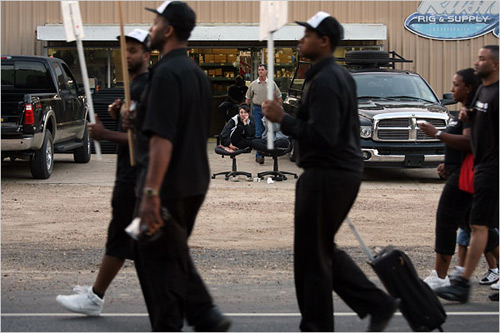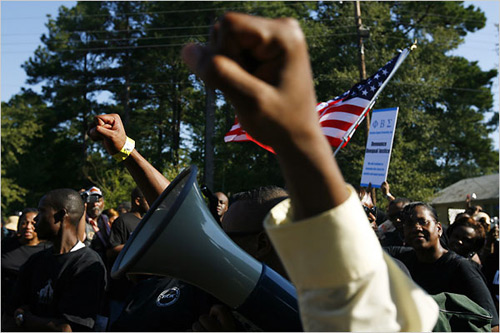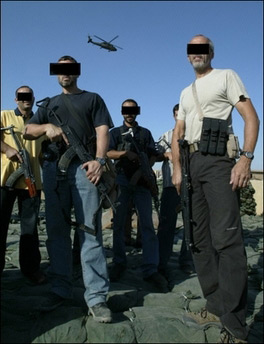Notes
Window On Jena


First off, I should say I haven’t looked at a wider cross-section of media images from Thursday’s march in Jena.
Through the window of the one NYT slide show, based on 12 photos by Times photographer Damon Winter, however, I have an editorial and a historical observation. (For easier reference, by the way, each image is numbered and linked to as a pop-up at the bottom of the post.)
From the accounts I read, it seemed the march was notably peaceful, even festive. This series of photos, however, seems to be “looking for trouble.”
For example:
In #1, notice the guy in the car (a Nation of Islam member, in the suit, doing a security thing?) seeming to photograph the photographer. It offers a paranoid subtext to me.
#7 is a portrait of the Nation of Islam “protection.” We’re these guys that prominent Thursday? Is it fair to put that much weight here? And, is that the same car (far left) that we saw in #1?
Again, is #8 (showing a verbal confrontation between two kids, basically — marcher and trooper) that representative of the day? Notice the three black troopers in the background looking more casual, by the way. So, does this shot really represent “tempers flaring between protesters and troopers,” as the caption says, or tension between marchers (or one marcher) and one (white) trooper?
I’m less sure about #4 and #5 on this thesis, but I do think it’s interesting both shots mostly isolate black men alone. In #4, outside Rusty’s Rig and Supply, you have what spatially reads like a white couple (although, on closer look, it seems pretty clear they are not together) “sidelined” by the black marchers in the road. (I’m wondering if the suitcase, pulled by the marcher — combined with the body language of the white girl, like she’s really stuck there, actually lends a more temporal sense, thus a hint of occupation.) Then, in #5, the shouting mouth — if a poignant conveyance of anger and frustration — seems as much a distorted and primitive vision, as if someone or something might end up bitten or swallowed.
I was also interested in these images as a generational snapshot, highlighting the aging of the civil rights movement. If inadvertently, it feels like this is the real story the photographer captured. Again, a few examples:
In #1, we have a striking case of two generations. Interestingly, the caption identifies the woman, Nikole Pollard, at left, but not the name or relation of the youth with her. This shot, and the others I’ll mention, however, made me wondering about the status of “the movement” and its lack of both newer faces, and an overall face or identity.
In #3, Reverend Sharpton (with the mother of he student at the center of the storm, Mychal Bell) is more a symbol of the old guard. #9 is even more striking in that regard. The photo is divided in half, the older marchers, in black, on the right, holding a photo of Dr. King, with the young kid, in white, left, and behind. (This photo probably gets even more complicated as the kid seems to be Latino.) The other generational signifier here, however, is the kids gesture, which is the primary subject of #6.
At this point, the sight of the raised fist — the Sixties symbol of black power — seems mostly ironic. I say that because its appearance here, in singular focus (against the American flag, no less), seems to evoke as much nostalgia as affirmation. Given the case at hand, however, I wonder how much the absence of the gesture (or any contemporary equivalent in person or coalescing symbol) has to do with racial progress, as opposed to pacification, or other sets of factors.
Image # 1
Image # 2
Image # 3
Image # 4
Image # 5
Image # 6
Image # 7
Image # 8
Image # 9
Image # 10
Image # 11
Complete slide show. Article link.


Reactions
Comments Powered by Disqus